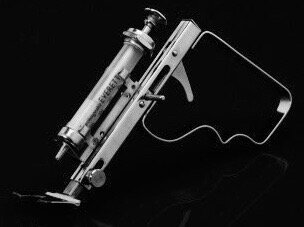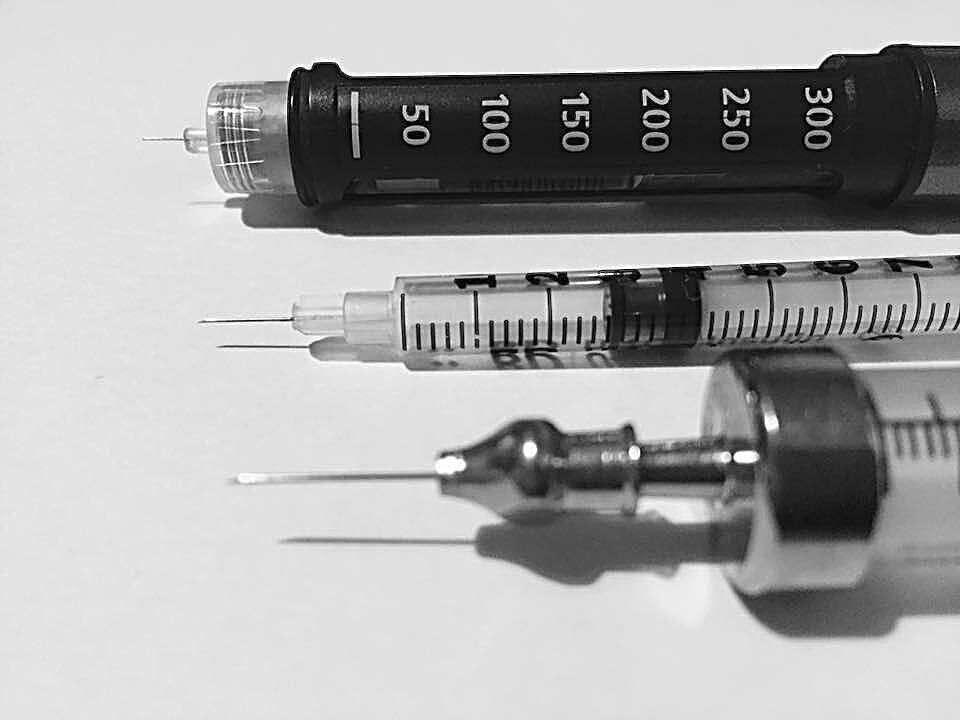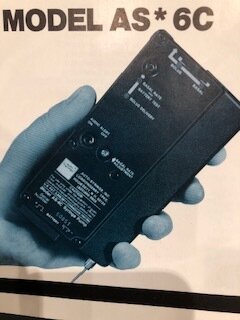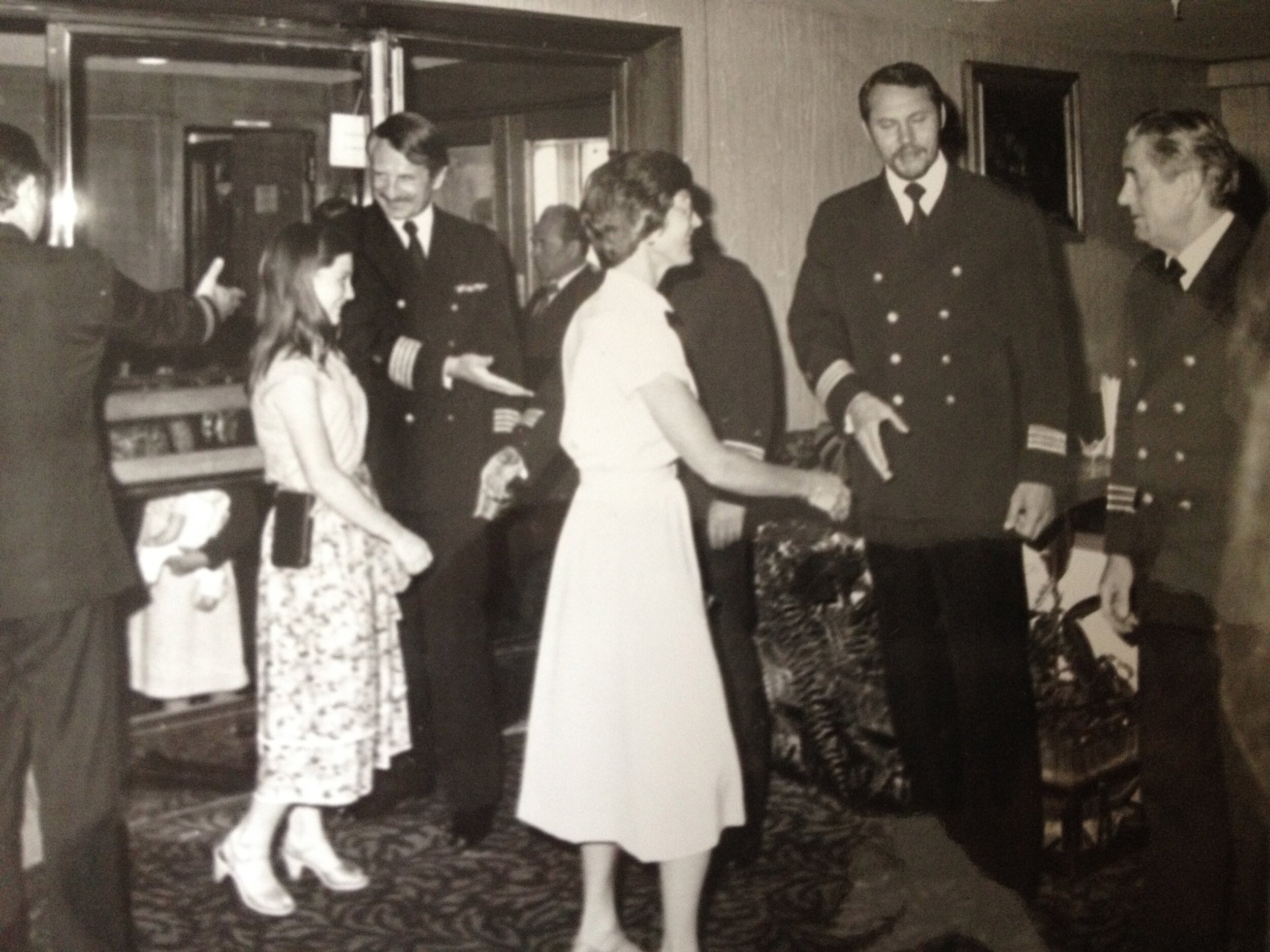40 weeks and counting: Injections and Insulin Pumps
1972-1978
Me: I was discharged from hospital on one injection a day of Lente insulin. Lente insulin was made by combining pork and beef insulin extracts with zinc. The addition of zinc caused the insulin to be dissolved into the body more slowly after injection. I remember being given an orange to practise injecting on in hospital. I had no issue injecting an orange. The idea of injecting myself was much harder to come to terms with.
Dad: Margaret's nursing training was a big help. She knew how to give injections, although she quickly found that it was much more difficult to inject your own daughter than a patient whom you did not know. In any case, we soon realised that it was important to help Sarah to take over responsibility for her own injections, initially under supervision. She needed to be able to administer the injections herself in case an emergency arose when Margaret and I were not able to be with her; and doing this was an essential preparation for her becoming reasonably independent, as time went by.
Mum: I feel that the most difficult aspect for me was the trauma I felt in giving you the daily insulin injections. Despite no longer working outside the home, I had trained as a state registered nurse in the late 1950s. I had given countless injections to patients but found it quite different from having to inject my own child. For months, I suffered nightmares during which I sat bolt upright in bed, utterly convinced that I had injected you into a vein or artery.
Me: I had a glass syringe for injections. It was stored in surgical spirit when not in use. The smell of the surgical spirit remained on your fingers for quite some time after touching the syringe and if I had a cut on my finger, the surgical spirit would always find it’s way into the cut and sting like crazy. I seem to remember being involved from the beginning in drawing up doses though the process of building up courage to inject myself took longer.
I had a supply of hypodermic needles in hard plastic cases with a hard plastic end that had to be prised off to be able to secure the needle to the syringe.
To help encourage me to learn to inject myself, we acquired a Palmer injector gun. The insulin would be drawn up into the syringe and the syringe clipped into the top of the gun frame. The top of the device would be pulled back priming the gun to be ready to fire the needle into the skin. Needles in the early 70s were long; the noise and speed of injecting as the trigger was pulled terrified me and no doubt as a result of tensing up, injections hurt. I am not sure whether I ever quite reconciled myself to the idea that this device was meant to help cope with injecting myself, when in my childish eyes it was a weapon.
Mum used the gun to inject into my backside. I remember standing facing her dressing table waiting to hear the sound of the trigger being pulled. The noise made me jump which in turn meant that I would pull away from the needle, pulling it partially out of my skin and requiring the process to be repeated. I remember Mum’s frustration at my reaction but recognise that it was a traumatic process for her too. As I was encouraged to take over the process, it felt as though I would sit there for an eternity, plucking up courage to pull the trigger.
Deb (Sister): The metal gun still makes me shudder. A new nightmare was unfolding where my poor sister had to do this to herself every day. The tension in the house was palpable and I just tried to keep out of the way and be as quiet as possible. I actually thought Sarah was very brave. I don’t remember any screaming or crying, just long moments of tense silence. My role as big sister was useless as I was unable to offer any help. I couldn’t give her a day off by having the injection for her. There was an enormous feeling of guilt for being the one who didn’t have to go through this, that has always stayed with me. I don’t know if time is taken today to explore all these emotions. However, for Sarah there was a rigid determination to master the injections and just get on with it. I accepted this was how things were and seeing Sarah with needles became the new normal.
Dad: I was devastated by the thought that Sarah would have the tiresome constraints of having to give herself insulin injections all her life. As we made progress towards Sarah’s injecting herself, the injections became a harsh daily ordeal for her. To help her do the injections, she had a spring loaded injector gun; she held the gun against her skin and triggered a release mechanism which plunged the needle into the skin. When the time came for the daily injection, she would often sit for several minutes, working to pluck up courage to “fire” the gun.
Me: It is interesting how my recollection of the time taken differs.
It took me some time to adjust to the trauma of daily injections. Towards the end of my first stay in Macclesfield Hospital at diagnosis, I had drawn a poster with another child on the ward, showing a picture of a syringe with a big red cross through it. We were proud of our drawing and showed it to a nurse. It was early evening, I think she was probably at the end of a long shift and possibly at her wits’ end with children confined to the ward and needing to let off steam. Her reaction was fierce, instant and frightening. We were shouted at and told not to be so silly - we would need injections for the rest of our lives. I am sure I have never vocalised my feelings about injections since this episode.
Once back into a routine at home, arriving home from school and stepping over the threshold would lead to a certain amount of internal emotional turmoil. I can see the concrete steps up to the front door and remember the feeling of dread, like I was entering some form of prison where there was no escape from the injection the following day. I obviously managed to reconcile myself to this over time but I still clearly picture our front door and that hesitation in stepping over the threshold.
The first bit of kit that I was truly excited about owning was a blue plastic box for keeping all of my injection supplies in. I was able to choose it as a prize after attending my first Diabetes UK children’s camp. It contained a sprung loaded storage tube for my glass syringe. You would unscrew the top and the syringe popped up, proud of the surgical spirit. There were also sections for storing vials of insulin, spare needles and injection swabs. I got a huge thrill from this piece of kit that brought together all the parts I needed for my morning injections.
Me: A few years into diagnosis I developed fat atrophy at the injection sites in my thighs. Large hollows appeared at the top of each leg which I now understand can be a common reaction to Lente. Although filtered, the body recognised the pork and beef insulin extracts as a foreign product and formed antibodies against it. At this point and for about the next three to four years I moved to two injections a day (pre breakfast and dinner) of a combination of quick and intermediate acting insulins – using both Soluble and Isophane or Actrapid and Semitard. I was told to inject into the hollows and they eventually disappeared.
This new routine required more preparation prior to each injection. The importance of drawing up the dose in the correct order and making sure the cloudy intermediate acting insulin did not contaminate the clear quicker acting insulin was drummed into me. I would need to roll the vial of cloudy insulin in my hands until the contents of the vial were evenly dissolved. Clear insulin would need to be drawn into the syringe before cloudy and air injected into both vials before starting the withdrawal of the clear insulin.
A number of years in, Mum and Dad started to buy disposable syringes for me to use instead of the glass syringe. Disposable syringes were not available on the NHS but made the process of injecting so much more bearable – quicker, easier and the finer needle gauge made pushing them into the skin less painful. I am sad that this is a side of the management of type 1 that so often goes unseen by the NHS or health professionals. It is not just access to drugs to stay alive that is important but access to improved methods of delivery that can have a huge impact on living with a condition like this.
1978-1990
Dad: In October 1978 we moved to the USA for three years. My main concern for Sarah was to make sure we had contact with an American doctor who would give her good care for her diabetes. We discussed the problem with Dr Price at Pendlebury. He told us that he knew, through attending international conferences, a Dr Bill Tamborlane, a specialist in childhood diabetes, working at the Yale University Medical School, in New Haven Connecticut. He was doing interesting research work and we could be confident that Sarah would be in good hands.
We packed some of our luggage, including a lot of spare syringes for Sarah, into an old sea trunk and sent it to JFK Airport in New York by air freight. It arrived after a few days and I drove with Sarah to collect it from the depot at the Airport. When the trunk had been located, the customs officer told me to open it for inspection. I did and a cascade of syringes fell to the ground. “I suppose you have an explanation for these,” the officer said wearily. I did. I showed him the doctor’s letter we carried, explaining Sarah’s condition as a type 1 diabetic. He took one look and waved us through.
After Dr Tamborlane had got to know Sarah, and saw how she was coping with her condition, he told her that he was working on a new research project, involving a trial of a new insulin pump. He asked Sarah if she would like to take part in the trial. She immediately and enthusiastically agreed.
Me: The research was scheduled to last a year and would compare the impact on results of spending six months on three injections a day with six months on an insulin pump.
I was initially assigned to the multiple daily injection (MDI) group and spent six months on three injections a day. I was really disappointed to be in this group. Having decided I wanted to participate, I was impatient to trial the pump. Six months later, after a stay of about a week in hospital to deal with the transition from MDI to the pump, I was let loose with the new gadget. (This is a whole other blog in its own right given how different this was from anything else I had ever experienced but I will summarise the basics). There was now no mixing of short, intermediate or long acting insulin. I was on a device that just infused short acting insulin. The pump was very basic by the standards of those in existence today. The infusion rate could not be varied so I was given a formula to use to dilute the insulin before filling the syringe, based on the assessments they had made of my body’s needs. The pump reservoir had to be changed daily and infusion sets were not specially made as they are today for ease of attachment to the skin. I had a butterfly needle that I inserted at a 45 degree angle into my stomach but there was no ready-made method of securing it in place. Instead, I had to devise a way of wrapping micropore tape around each side of the plastic wings on the needle to secure this to my stomach.
I remember feeling very self-conscious initially about wearing this device that offered a very obvious and constant reminder to my peer group that I was different. I was the only girl in the high school jazz group – playing alto saxophone – and there was a boy in the group that I had a bit of a crush on. I still recall the embarrassment I felt the first time I walked into a rehearsal with the pump attached. Having had a week away from high school for the transition to the pump, I was convinced that people were surreptitiously noting this large piece of kit attached to my jeans.
Marty (High School friend): Even when noticed, I don’t think other kids thought it weird because at the time, Sony Walkmans were popular and the pump looked quite similar. If anything, the fact that you pulled out the pump and pressed a button to dose insulin rather than pulling out a needle made everyone less squeamish. Other than the thought of you being permanently stabbed in the abdomen, I was fascinated by the technology and just thought it was super cool. I did think it unfair though that you still had to prick your finger to test blood sugar levels to tell the pump what to do. Why couldn’t it do both?
Me: So why participate? It all came down to my belief in the physical benefits. Experiences at diagnosis and in school had shown me that I was not the same as other people. No matter how much I may have wanted to be the same and behave in the same unplanned, spontaneous manner, I couldn’t. The very unsophisticated treatment available in my first eight years of diagnosis already made me conscious of how much time I gritted my teeth and just persevered with the feelings that high or low blood sugar caused. This was the first time I really felt there was a chance, even if I looked different, of being able to participate more easily with the plans of my peer group.
And my first memorable spontaneous action – something very ordinary and non noteworthy in anyone else’s daily life… was queuing up in the high school canteen to buy myself a chocolate chip cookie. The canteen sold large soft chocolate chip cookies. I never purchased my lunch – I always took in my “brown bag” lunch as it was cheaper and easier to carbohydrate count. (This was still the era of eat to match the insulin in your system, not inject to match what you wanted to eat.) The pump however was the first opportunity where this could change - I could be in control of when and what to eat. Buying a chocolate chip cookie was a good way to celebrate this power shift!
It was life changing. I will always have a place in my heart for Dr Bill Tamborlane. So much of where I am today and how I have learnt to manage the condition I feel has originated, whether consciously or subconsciously, from my participation in this research and his interest, time and involvement in the training and care we were given.
The pump was such a success that Mum and Dad bought it, enabling me to continue using it when we returned to the UK in 1981. I continued using the Auto Syringe Inc pump for a further ten years having to have pump consumables specially shipped over from the US.
1990-2008
Me: After ten years on the pump and a tummy that was running out of suitable sites for needle rotation, I spent time with my HCP team considering whether to try moving onto MDI. For the next 18 years this worked reasonably well. It gave my stomach a break and there were some quite funky injector pen designs produced. I’m all in favour of “injecting” some colour and fun into the tools for managing the condition and a pen with pictures of elephant bottoms on certainly did that! I was on a prescribed 4 injections a day routine – long acting human insulatard at bedtime and three injections of actrapid before meal times. Of course one can never keep to 4 a day because if you want freedom of choice with food you need to inject to match when you choose to eat. So, 4 could easily turn into 5, 6 or more to allow me to snack, or cope with eating during extended family gatherings or trying to safely pre-bolus when eating out.
2008-2010
Me: With hindsight, this routine had been working less and less well for some time but when changes happen gradually, you don’t always pick up on the problems. I was having more unexplained difficulties – highs or lows that I would not have expected in my normal routine. Initially it left me surprised as I tried to figure out what was causing changes that I felt should not be happening based on my understanding of my diabetes. I started to experience more overnight and fasting hypos. Over a period of probably six months, I reduced my overnight insulin in 2u increments going from 20u down to 12u. I felt I was suffering from a change in the duration of insulin action time. No matter how much I dropped my long-acting dose, I would be having mid-morning hypos, unrelated to breakfast insulin. I had a couple of days at work where I had injected for lunch and for various reasons, I had been delayed in my ability to eat. Yet even with a 4u lunchtime dose and no carbohydrates, I did not have hypos. The days I had my normal insulin dose and lunch, my blood glucose would regularly climb to between 15 mmol/l and 17 mmol/l between 4 and 5pm.
I went to my GP, explained the issues I was having and asked to be able to return to pump usage. He said he would happily refer me to the local hospital (I was receiving type 1 care only from my GP at that stage) but he felt I would struggle to be successful with my request. I did struggle and what followed were possibly the two worst years of my life managing type 1.
I was taken off Human Insulatard and placed onto Levemir for its more predictable long-acting duration. However, I had two weeks of bad side effects including pain and bruising at injection sites. With injection site rotation it got to a point where I couldn’t face being touched or hugged. I took photos of the affected areas and reported these problems to the hospital stating I could not bear to stay on Levemir any longer.
I was placed onto Glargine. The bruising and pain disappeared over the following weeks but the same management issues continued. My overnight dose was eventually reduced to 9u from my original 20u but I continued to hypo mid-morning and have blood glucose readings that climbed to levels between 14-17mmol/l by late afternoon. I would give myself two or three correction doses to try to limit the climb. Dinner times were fraught as there was no point trying to eat before my insulin dose had returned my blood glucose levels to normal which could take a long time with readings that high.
I was on a treadmill from which I could not escape. Local hospital appointments every three months played around with insulin doses which had no impact on mid-morning lows or late afternoon highs and resulted in a steadily increasing HbA1c. Although capable of adjusting my own insulin doses, I had agreed to hand control over to the hospital in an attempt to find a solution. However, nothing made a difference. The impact of roller-coaster readings was exhausting and not detectable through a three monthly HbA1c reading which remained below the magic NICE guidance of 8.5% which if exceeded, would be more likely to allow access to a pump. I was told that the only other access criteria – disabling hypoglycaemia – would lead to questions asked about my suitability to hold a driving licence. I had already self-imposed a driving ban mid-morning due to not trusting myself to be safe behind the wheel and did not want an externally imposed one – that was not the answer.
My desperation came to a head. We still had no mutually agreed plan of action or timescale and I could not see an end in sight. I felt life was passing me by as I hung in there feeling that I was only just coping with the physical impact that this was having on me. I sat and cried at the end of one appointment; no new conversation was started and I would be seen in another three months; I couldn’t contain my sobs as I walked out of the centre. I cried in the car. I felt completely broken.
I returned to my GP to ask for help. Much as I was frustrated by my GPs continued refusal to refer me out of area for an alternative opinion, he knew me, my personality and how I had successfully managed my type 1 over the previous years. I was not the sort of person to complain about problems that were not there. He said he would speak to the hospital doctor.
2010-2021
Me: Two years after my first request I was eventually set up with a Medtronic pump in April 2010. From the battle I had had trying to manage doses over the previous two years, I was already confident in knowing the sorts of doses my body needed at different times of the day and spent very little time adjusting to programming appropriate infusion rates into the pump. The hospital let me get on with it and I now felt relief at having a tool that was better able to manage this stage of my life.
I have a snapshot image of walking to collect my daughter from dance one Saturday afternoon. It was a 15 minute walk up a steep hill, the sun was shining, my blood glucose was in range and I was not having to grit my teeth to find the energy to manage routine daily tasks.
Eleven years later and I am still on an old Medtronic paradigm pump. Pump warranties last for 4 years and so regardless of improvements to technology, once a pump has been issued to you, that is the model you stick with until your 4 year anniversary allows a new choice. The technology is moving on rapidly and I look longingly at the social media posts from those that have already managed to gain access to more advanced pump models that now communicate with continuous glucose monitoring equipment.
I need to be patient for just a little while longer. A new pump should be due in my 50th year of diagnosis and there are some exciting models and technological advances making their way into the patient domain. As my high school friend Marty stated “I did think it unfair though that you still had to prick your finger to test blood sugar levels to tell the pump what to do. Why couldn’t it do both?” Forty-two years after accessing my first pump, I hope that this will soon become a reality for me.





